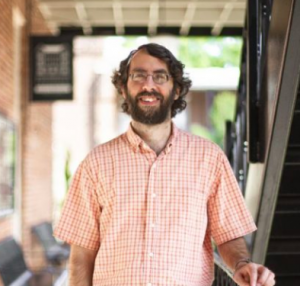“On the Spot” backs members of Culture on the Edge into a corner to talk about their backgrounds, their ongoing work, and what might be gained by an alternative understanding of how identity works.
 1) When people ask what you study, what do you tell them?
1) When people ask what you study, what do you tell them?
Typically, I respond with the straightforward “Religions of India, like Hinduism and Islam” or “Religions of Asia.” While the answer prompts some people to talk about whomever they know who is from India or has visited India, the perceived exotic nature of India, Hinduism, and Islam means that fewer people are confident to start a lengthy discourse about India, as some people do if I simply answer “religion.”
2) How do questions of identity manifest in your research?
My initial intention was to study the difference between strict religious identifications and the fluidity of practice, as many in India participate in practices that we commonly identify with competing religions. Self-identified Hindus not only celebrate festivals with their co-workers and friends who identify as Muslim, but they also often pray for healing or assistance at Sufi shrines. Similarly, self-identified Muslims have cooperated with Hindus in both ritual and non-ritual practices, even serving as sponsors and performers in particular festivals. And the same dynamics play out among people who identify as Sikh, Jain, or Christian in many parts of India.
A related identity question, however, developed during my research, as it became apparent that diverse conceptions of practices and boundaries raised the issue among people in India of who counts as a Hindu, Muslim. Jain, Sikh, or Christian. These more rigid arguments not only add complexity to the flexibility of practices that I began studying, but they also have significant consequences for groups whose self-identification comes into question, leading them to contest the dominant definitions of who counts as a follower of their particular religion.
3) Can you give us an example of this from your previous work?
My primary research topic, and first book, focused on people who identify as Hindus from the region of Sindh, now in Pakistan. Many migrated to India after Sindh became a part of Pakistan at Partition because they identified as Hindu, an identification that others in Sindh recognized. However, after migration, others in India questioned (and continue to question) the Hindu identification of some Sindhi Hindus because their forms of Hinduism did not match standard notions of Hinduism in India. Many Sindhi Hindus identified as devotees of Guru Nanak and the Guru Granth Sahib, elements that people in India more commonly label as as being a part of Sikhism, and thus a separate religion. The photo above of the canopy in the Hari Om Mandir, Lucknow, India, illustrates the veneration of Nanak alongside Rama and Krishna, among other elements. Moreover, some who identify with Sindhi Hindus were devotees of Sufi masters in Sindh, even identifying themselves as Hindu Sufis. Even though many in India visit Sufi shrines, whatever their religious identification is, identifying as a specific follower of a Sufi or venerating the Guru Granth Sahib made their Hindu-ness suspect. Competing understandings of Hinduism, Sikhism, and Sufism in India created significant frustration among some Sindhis that they were Hindu in Sindh at Partition but were not fully accepted as Hindu in India, the independent nation comprising Hindu majority areas after Partition.
4) Where are you hoping to go next with your scholarship?
My research has moved from the ethnographic work with Sindhi Hindus to reflections on the implications of their experiences (and those of many others) for the ways that we discuss religions. I have written about the attention that scholars should give to our presentation of classifications such as Hindu and Sikh, since we are often taking sides in debates over these labels without necessarily intending to do so, and thus furthering the marginalization of non-dominant groups (in the first volume from Culture on the Edge Book Series). I am now extending those reflections to consider alternative ways of describing in general, considering the critiques of power and the construction of knowledge and historical description that colleagues have been generating, drawing on the work of Hayden White, Arlette Farge, and other historians.
